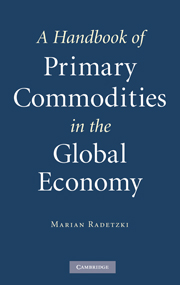Book contents
- Frontmatter
- Contents
- List of figures
- List of tables
- Acknowledgments
- Introduction
- 1 The historical framework
- 2 The geography of commodity production and trade
- 3 Comparative advantage and the trade policy distortions
- 4 Price formation and price trends in commodities
- 5 The commodity exchanges, commodity investments, and speculation
- 6 The economics of exhaustible resource depletion
- 7 Fears of, and measures to assure, supply security
- 8 Producer cartels in international commodity markets
- 9 Public ownership in primary commodity production
- 10 The monoeconomies: issues raised by heavy dependence on commodity production and exports
- References
- Index
4 - Price formation and price trends in commodities
Published online by Cambridge University Press: 23 June 2009
- Frontmatter
- Contents
- List of figures
- List of tables
- Acknowledgments
- Introduction
- 1 The historical framework
- 2 The geography of commodity production and trade
- 3 Comparative advantage and the trade policy distortions
- 4 Price formation and price trends in commodities
- 5 The commodity exchanges, commodity investments, and speculation
- 6 The economics of exhaustible resource depletion
- 7 Fears of, and measures to assure, supply security
- 8 Producer cartels in international commodity markets
- 9 Public ownership in primary commodity production
- 10 The monoeconomies: issues raised by heavy dependence on commodity production and exports
- References
- Index
Summary
Factors determining price levels in the short and long run
Commodity prices in unregulated competitive markets are basically determined at each point in time by the intersection of the short-run supply and demand curves. In figure 4.1 price will settle at P1 if S and D1 represent the supply and demand schedules, respectively. There is nothing special about commodities in this regard; all unregulated competitive markets behave in this way. In the short run, the capacity to produce (or the area of land under a specific crop cultivation) is given, and the supply schedule depicts the variable cost levels in existing production units, ranked in ascending order. Natural advantage, managerial efficiency, or a high proportion of fixed costs will yield low variable cost levels, and vice versa.
Capacity will be used to produce so long as the variable costs are covered by price. A rise in demand, demonstrated in figure 4.1 by a rightward shift of the demand schedule from D1 to D2, will require the employment of additional production units, and their higher variable costs will push up the price to P2. Such a shift could be caused by the secular economic growth from one year to the next, by a cyclical upturn in business conditions, which increases the demand for current consumption as well as for user inventories. or simply by the expectations, rational or irrational, of an impending price increase, which result in a surge in inventory demand for speculative purposes.
- Type
- Chapter
- Information
- A Handbook of Primary Commodities in the Global Economy , pp. 57 - 85Publisher: Cambridge University PressPrint publication year: 2008



